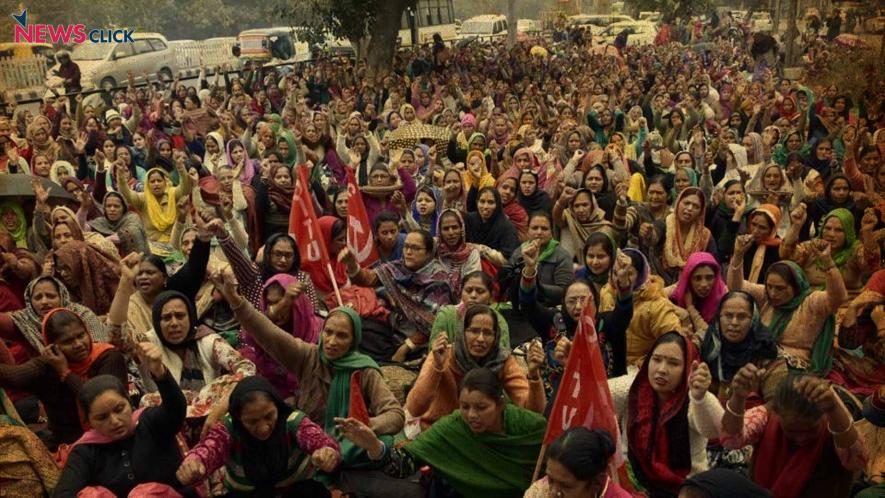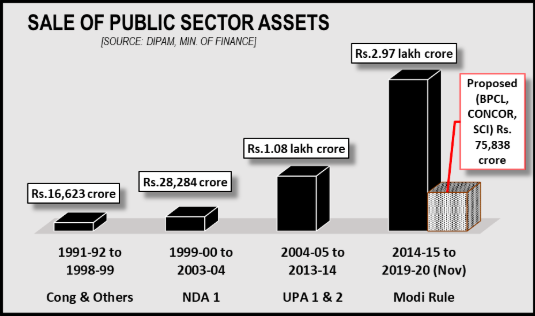January 8 Strike: Protest Against Record Sale of National Assets by Modi Govt

One of the key demands being raised by workers going on a historic general strike on January 8, 2020, is the end to reckless sale of public sector assets by the Modi government. According to data put out by the finance ministry’s department of investment and asset management (DIPAM), the BJP government has sold off Rs 2.97 lakh crore worth of public sector assets in its rule since 2014. If you add the proposed sale of BPCL, CONCOR and SCI, the combined net worth of which is estimated at about Rs 76,000 crore, the total disinvestment done by Modi government reaches Rs 3.73 lakh crore.
This is nearly three times more than what the Congress-led United Progressive Alliance governments disinvested over 10 years of their rule (2004-14). As the chart below shows, the BJP government has been much more enthusiastic and energetic in this than any other government of the past. This is strangely ironic because the Modi government tirelessly proclaims itself to be a ‘nationalist’ government – and yet it is hollowing out the country’s economic backbone.

This drive for disinvestment of India’s public sector needs to be seen in the context of the full package of policies that the Modi government has been pursuing. Besides destroying the public sector and handing over bulk of these assets to the private sector, it has also fundamentally changed the existing labour laws in favour of the corporate class, given huge concessions in taxes to corporate entities, invited foreign conglomerates to take over important sectors, such as defence and mining, used government funds to bail out sinking private companies without seizing any assets of their owners, allowed various economic fugitives who had embezzled several thousands of crores of public money to flee the country and created so much unemployment that the whole economy is now in a deathly tailspin.
But the Modi government continues blithely with its policies because this is what they were supposed to deliver to the big industrialists. All these policies actually represent big gains for big corporates while destroying the working people, employees, the middle class and even small entrepreneurs.
How the Country Loses by Disinvestment
The continued programme of disinvestment of public sector units will inflict grave damage to the country in several ways. First and foremost, it will mean that workers and employees in these units will face large-scale loss of jobs and drastic changes in their service conditions.
Public sector jobs were considered secure and reasonably well paid in comparison to private sector jobs. They also came with many benefits, including social security, educational opportunities for employees’ children, transport and residential facilities etc. Although many of these had been whittled down over the years and the workers/employees had to struggle relentlessly to preserve their benefits, but still, these were valuable advantages. With disinvestment, the private stakeholders will adopt the standard approach to profitability at all cost, even if it means cutting down on workers’ numbers and wages/benefits.
Equally important is the effect this disinvestment will have on the country’s economy. Each of these public sector units contributed considerable tax revenue and dividends to the government every year. All that will be lost now because private ownership means those profits will now go into the pockets of new private shareholders. For example, BPCL paid taxes worth Rs.4,377.52 crore in 2018-19 and after that, it had a profit of Rs.8,527.85 crore. In the future, after a private entity takes it over, the paid taxes may fall (because private sector undertakes all kinds of tricks to evade taxes) while the total profit will go to some private hands.
Similar is the fate of all other public sector units that are being privatised. Even where complete disinvestment doesn’t take place, loss will take place proportionate to share divested.
There are other types of dangers lurking in the future. Some measure of that can be had from looking at how the private sector firms are behaving currently – their services are deteriorating, there is no accountability, they raise prices arbitrarily, they are linked to international ups and downs, and the consumers suffer. If they sink, nobody is accountable. This is the future that awaits Indians once Modi’s destructive regime achieves its dreams.
Economic Crisis & Divisive Politics
Meanwhile, even as the country sinks into a deathly slowdown, unemployment has continued to skyrocket like never before. The jobless rate has remained over 8% over the past several months. Food prices are continuing to rise although government warehouses are overflowing with foodgrains, and there is a wave of retrenchments and lay-offs in the industrial and services sectors.
The government is thinking that it can bludgeon its way out of this crisis simply by handing out more and more concessions to industrialists and big traders, refusing to realise or acknowledge that the crisis is caused by lack of buying power in the hands of people. This requires a boost in government spending, increase in rural and industrial wages, better prices to farmers for their produce and expansion of employment opportunities.
But rather than take these measures, the government has fallen back upon its standard policy of fanning divisive flames across the country. It first scrapped the autonomy given to J&K in August and put the Valley under a lockdown, which continues after nearly five months. Then it stirred up the citizenship issue by amending the Citizenship Act and proposing to bring in a National Register of Citizens (NRC), which not only militates against the constitutional values of secularism and equality before law, but also creates divisions in the fragile fabric of society.
Protests against the new law and proposed NPR/NRC have been crushed ruthlessly in places like Uttar Pradesh and Delhi, with internet suspension, police-initiated violence against families (mainly of minority community) and arbitrary fines against alleged protestors.
Workers’ Resistance
The working class – both, in the public as well as private sector – has valiantly led the fight against Modi government’s policies of disinvestment, among others. In the past six years, there have been three historic all-India strikes, a mahapadav at Parliament, several strike struggles by industry sectors and a growing solidarity with peasant struggles. All trade unions (except the BJP/RSS affiliated Bharatiya Mazdoor Sangh) have forged a unity in these struggles. This massive and united resistance has forced the government to hesitate and even reconsider some issues. But on other issues, the government has gone ahead.
The coming strike on January 8, 2020 to protest against all these anti-worker policies is another step forward in this struggle. The farmers, too, will join on the first day and observe a grameen bandh (rural shutdown or strike). It is only through the strength of these struggles and their striking power that the Modi government will be forced to rethink their policies.
Get the latest reports & analysis with people's perspective on Protests, movements & deep analytical videos, discussions of the current affairs in your Telegram app. Subscribe to NewsClick's Telegram channel & get Real-Time updates on stories, as they get published on our website.
























